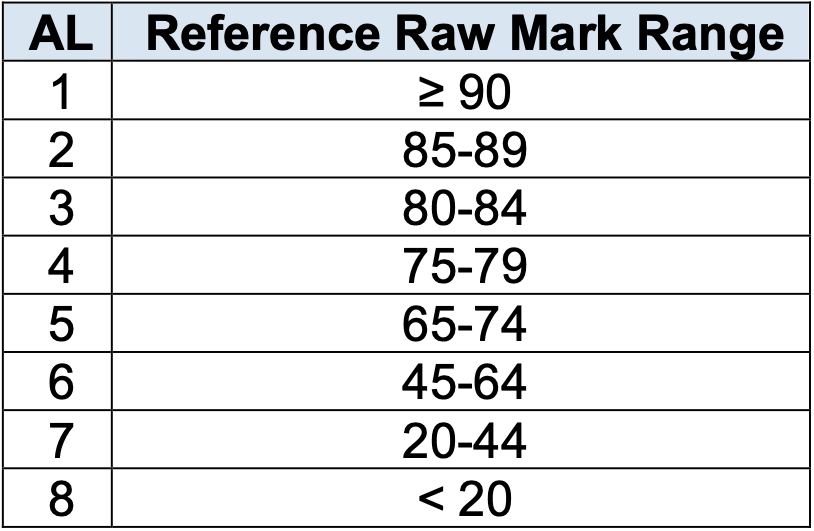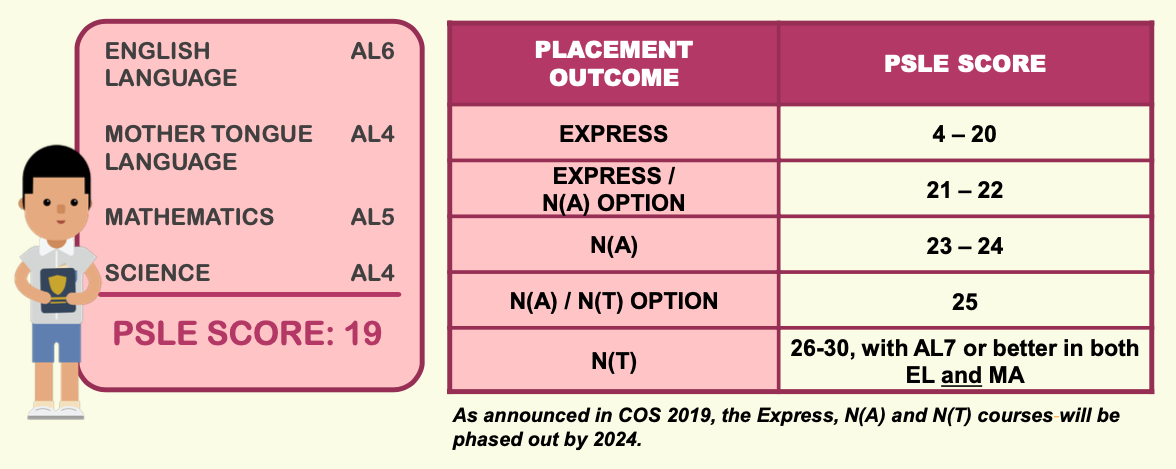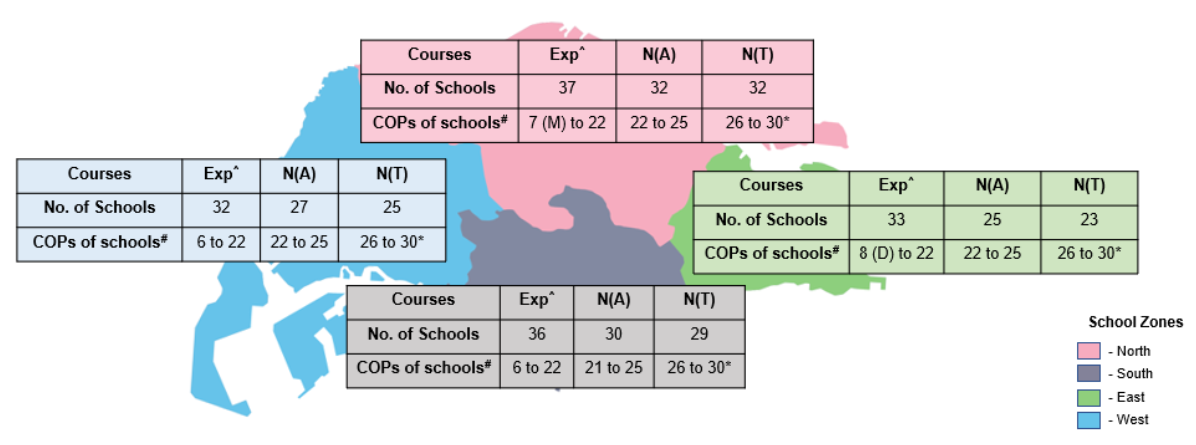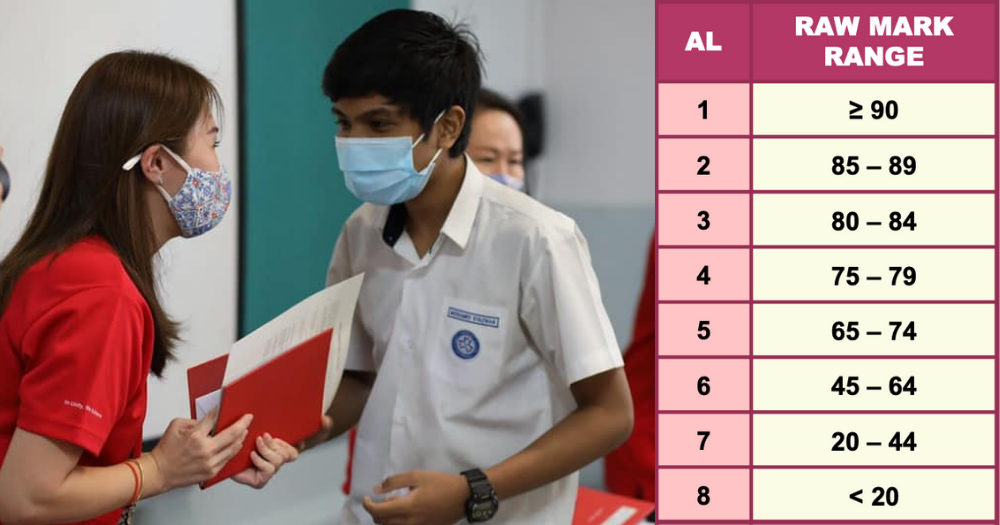Follow us on Telegram for the latest updates: https://t.me/mothershipsg
Starting in 2021, students taking the Primary School Leaving Examination (PSLE) will no longer be scored based on how well they did relative to their peers, but rather, on their individual performance in the subjects.
The new PSLE scoring system, which uses Achievement Levels (ALs) rather than T-scores, is part of the Ministry of Education's (MOE) efforts to move away from over-emphasising academic results.
Achievement Level scoring system
Under the new AL scoring system, each PSLE student will be scored using eight ALs, with AL 1 being the highest score and AL 8 being the lowest.
 Table via MOE.
Table via MOE.
The eight ALs are set based on the learning objectives of the curriculum, and are designed to reflect students' levels of understanding and mastery of a subject, MOE said in a press release on Tuesday (Apr. 27).
A student's AL for each subject will reflect their own level of achievement, rather than how they performed relative to their peers. This will allow students to set goals and work toward their desired aggregate score with more certainty, said MOE.
Students taking Foundation level subjects are graded from AL A to AL C, which are mapped to AL 6 to AL 8 of Standard level subjects respectively, for the purpose of the Secondary One (S1) posting exercise.
 Table via MOE.
Table via MOE.
This is because the curriculum of a Foundation level subject is a subset of a Standard level subject, said MOE.
The sum of the student's ALs across their four subjects is the PSLE score, which ranges from four (the best possible score) to 32.
Indicative PSLE score ranges for secondary schools
Under the AL scoring system, there are only 29 possible PSLE scores, compared to the more than 200 possible aggregate scores under the previous T-score system.
This means that schools will also be less differentiated based on cut-off points (COPs), so students will have a wider range of secondary schools to choose from.
MOE has published the indicative PSLE score ranges of all 139 secondary schools taking part in the 2021 S1 posting exercise on SchoolFinder here.
These indicative PSLE score ranges reflect the score of the first and last student who would be posted into each school under the AL scoring system, based on the 2020 cohort's PSLE results and school choice patterns.
The PSLE score of the last student posted to a school is referred to as that school's COP.
Based on 2020 indicative PSLE score ranges, the indicative COPs for secondary schools start from six.
School's score ranges may vary from year to year, depending on the cohort's PSLE results and their school choices in the previous year's S1 Posting Exercise. These fluctuations may typically be by one AL.
Students will also continue to be admitted to their courses — Express, Normal (Academic), and Normal (Technical) — based on their overall PSLE score.
For example, this student who earned an AL 6, AL 4, AL 5, and AL 4 would be placed in the Express stream, as the PSLE score is less than 20.
 Image via MOE.
Image via MOE.
MOE said that under the new PSLE scoring system, the proportion of students qualifying for the different courses is expected to be broadly similar, as the curriculum and assessment standards have not changed.
Tie-breakers for S1 placement
Similar to the T-score PSLE system, students will continue to have six options in selecting their secondary schools and will be posted based on academic merit.
This means that a student with a better PSLE score will be admitted to a school ahead of a student with a poorer PSLE score.
In cases where two students with the same PSLE score are vying for the last place in a school, the first tie-breaking factor will be citizenship. A Singapore citizen will be admitted ahead of a Singapore permanent resident, who will be admitted ahead of an international student.
If two students vying for the last spot in a school have the same PSLE score and citizenship status, the next tie-breaker will be based on school choice order.
This means that the student that ranked the school higher will be considered first.
The final tie-breaker, should all three of the previous factors — academic merit, citizenship, and school choice order — be the same, will be decided by random computerised balloting.
In a virtual briefing on Tuesday (Apr. 27), MOE told media that it expects that only one in 10 pupils will need to undergo balloting.
HCL advantage for SAP schools
Students applying for admission to Special Assistance Plan (SAP) schools will receive a posting advantage if they pass Higher Chinese Language (HCL).
If students with the same PSLE Score are vying for limited places in the same SAP school, those with better HCL grades [in the order of Distinction (D), Merit (M) and Pass (P)] will be allocated a place ahead of other students.
This posting advantage applies before the tie-breakers mentioned above for S1 posting.
For SAP schools, the indicative PSLE Score ranges will include HCL grades. For example, the indicative PSLE score range of 2020 for a school's Express stream could be 5 (D) – 12 (P).
This indicates that the first student admitted in 2020 would have scored AL 5 and gotten a Distinction in HCL, while the last student admitted would have scored AL 12 and gotten a Pass in HCL.
This means that in the 2020 S1 Posting Exercise, a student with a PSLE Score of 12 that did not obtain a Pass in HCL or did not take HCL would not have been admitted.
However, a student with PSLE Score of 11 who did not take HCL would have been admitted, as 11 is a better PSLE Score than the COP of 12 (P).
While students do not need to take HCL in order to enter SAP schools, students who pass HCL will receive a posting advantage for admission.
Look beyond COPs when choosing schools
In the media briefing, MOE emphasised that parents and students are encouraged to look beyond the cutoff points when choosing schools, and to look at schools holistically.
For example, they are encouraged to consider other "equally important factors" when considering what school would be a good fit for a student's overall learning needs, such as a school's distinctive programmes, co-curricular activities, ethos and culture, and distance from home.
MOE also stressed that there is also a good spread of schools with a range of COPs across school zones.
 Image via MOE.
Image via MOE.
In addition to schools' COPs, SchoolFinder also has more information about the holistic offerings of the secondary schools that are part of the S1 posting exercise.
Students can also consider the Direct School Admission (DSA)-Secondary — which is meant to recognise students' diverse talents and achievements in areas not demonstrated in the PSLE, such as sports, performing arts, and leadership — as an alternative admission pathway.
More information on the DSA-Sec 2021 Exercise will be released in May.
Subject-based banding
Under the new PSLE scoring system, students in the N(A) and N(T) courses will continue to be eligible to take subjects at a more demanding level at Secondary 1, based on their PSLE AL scores for individual subjects, rather than their overall PSLE score.
If a student earns a grade of AL 5 or better in a subject, they have the option to take that subject at the Express level. If they earn a grade of AL 6 or better — or AL A for a foundation subject — they can take the subject at the N(A) level.
MOE added:
"As students progress in secondary school, if they demonstrate aptitude and competencies, they will have further opportunities to take subjects at more demanding levels at various junctures, to further pursue their strengths and interests, and develop to their fullest potential."
Top photos via Facebook / Maliki Osman and MOE.
If you like what you read, follow us on Facebook, Instagram, Twitter and Telegram to get the latest updates.
